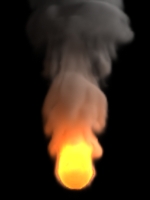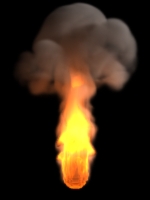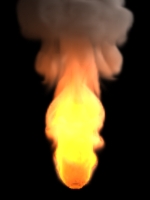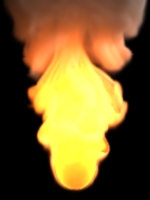Fuel
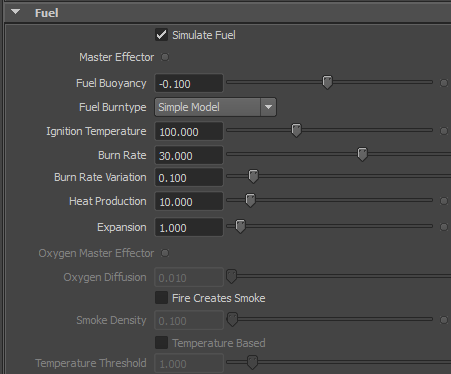
Simulate Fuel – Enable it to include fuel in the simulation.
Master Effector – By using this Effector you can directly affect Fuel content of each voxel.
Fuel Buoyancy - With this parameter you can affect the buoyancy of the fuel, so it can become affected by the gravity as well. Negative values will cause fuel to fall, while positive values will cause fuel to rise.
Burning Process
Simple Model – This model assumes that there is an abundance of oxygen in the grid and that the burning process is limited only by the temperature and fuel content of each voxel.
Model With Oxygen – It uses one additional field to model the burning process – oxygen. Each FumeFX Source has an option to emit oxygen into the grid. When oxygen is mixed with fuel and when temperature is above the Ignition Temperature, it will result in combustion. During the combustion process, a fuel and oxygen amounts are reduced and temperature is increased. However, oxygen can be replenished to some extent by the diffusion process.
Ignition Temperature - Fuel will burn in each voxel with a temperature equal to, or greater, than this value.
Burn Rate - The percentage of fuel in each voxel that is burned with each frame. Heat production and Expansion depend on the amount of burned fuel.
|
|
|
|
|
Burn Rate: 20.0 |
Burn Rate: 30.0 |
Burn Rate: 40.0 |
Burn Rate Variation - This is the maximum variation allowed in the burn rate, expressed as fraction.
Heat production - This determines the rate of temperature increase per burned fuel. With high heat production, temperature in the grid will increase, causing fluid to rise faster (due to the buoyancy parameter).
Expansion - This determines the rate of pressure increase per burned fuel. Excessive expansion can create extreme velocities and cause simulation times to increase significantly.
|
|
|
|
|
Expansion: 1.0 |
Expansion: 1.5 |
Expansion: 2.0 |
Oxygen Master Effector – By using this Effector you can directly affect oxygen content of each voxel.
Oxygen Diffusion – The rate of diffusion will determine the shape of the flames. High diffusion rates will result in a candle like flames. Large scale fire effects should use a very low diffusion parameter value – preferably zero.
Fire Creates Smoke - If you enable this option, smoke will be created on the surface of the flame; usually, it is created on the source.
Smoke Density - This amount of smoke density is added to the voxel when fuel approaches zero.
Temperature Based - If you enable this option, smoke can be created based on the temperature.
Temperature Threshold - When temperature of the fire reaches this value, smoke will be created. Using this method smoke formation can occur further away from the source then using default method.


